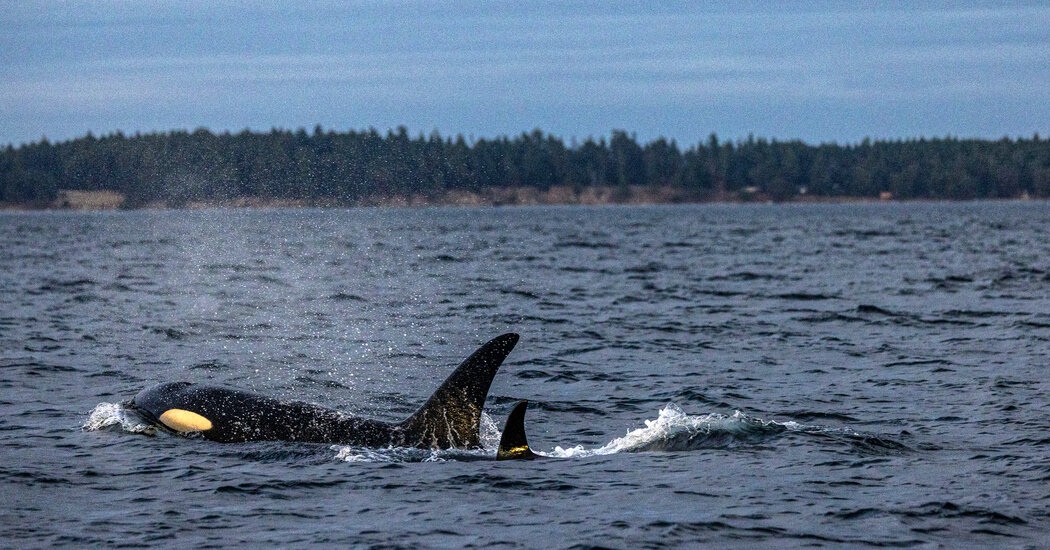
Killer whales are some of the most cosmopolitan creatures on the planet, swimming in all of the world's oceans. They patrol the frigid waters near both poles and periodically appear in the tropics, in locations from West Africa to Hawaii.
Although their habitats and habits vary widely, all orcas are considered part of a single global species: Orcinus orca. (Despite their common name, orcas are actually part of a family of marine mammals known as oceanic dolphins.)
Now, scientists have drawn on decades of research to suggest that two populations of killer whales often observed off the Pacific coast of the United States and Canada are actually so different from each other – and from other killer whales – that should be considered separate species.
In a paper published Tuesday in the journal Royal Society Open Science, scientists proposed giving new species designations to two groups of animals, one known as resident killer whales and the other often called Bigg's killer whales. Although both types live in the eastern North Pacific, they have different diets: resident orcas eat fish, with a particular predilection for salmon, while Bigg's orcas prey on marine mammals such as seals and sea lions.
The proposal documents numerous other behavioral, physical and genetic differences between the two orca populations, which evolved away from each other for hundreds of thousands of years, the scientists noted.
“These two types are genetically two of the most distantly related types anywhere in the world,” said Phillip Morin, a geneticist at the Southwest Fisheries Science Center at the National Oceanic and Atmospheric Administration, or NOAA, and an author of the study. “They're not just behaving differently. They're really on these evolutionary trajectories that we consider different species.”
There is no single definition of what qualifies as a species, and the boundaries between animal populations are often blurred. But these kinds of taxonomic distinctions may have implications for conservation, the scientists said, allowing experts to make more informed decisions about how to manage different orca populations.
“They face different threats,” said John K. Ford, an orca expert and scientist emeritus at Fisheries and Oceans Canada, who was not the author of the new paper.
In recent decades, for example, recovering numbers of seals and sea lions have helped fuel a population boom for Bigg's orcas, he said. Resident orcas, on the other hand, are threatened by dwindling wild salmon stocks.
Dr Ford said the authors of the new paper presented “a very strong case”, piecing together a growing body of evidence that resident killer whales and Bigg's killer whales are distinctly different creatures. “It's these multiple lines of evidence that all point in the same direction,” he said.
The next step will be to present the proposal to a committee of taxonomy experts at the Society for Marine Mammalogy, which maintains “the most authoritative list” of species, Dr. Morin said.
In recent years, scientific advances have allowed scientists to conduct more sophisticated analyzes of killer whale genomes. The data suggests that Bigg's killer whales branched off from other killer whales between 200,000 and 300,000 years ago. The residents, for their part, diverged from other orcas about 100,000 years ago. Genetic and behavioral analyzes also suggest that there has been little interbreeding between Bigg's killer whales and resident killer whales in recent years.
“It's very compelling evidence to suggest that they represent different species,” said Kim Parsons, a geneticist at NOAA's Northwest Fisheries Science Center and an author of the study.
Overall, the genomes were diverse enough that scientists could predict, with high accuracy, whether a killer whale was a Bigg's killer whale or a resident killer whale based on its DNA alone.
The shape of the skull is equally predictive. Bigg's killer whales have larger and broader skulls, with more deeply curved jaws, than residents – traits that could help them fight their larger prey. Bigg's killer whales are also slightly larger than general residents, with broader, more pointed dorsal fins and different black-and-white spotting patterns.
There are also behavioral differences. Resident orcas live in large, stable groups and are known to be talkative and communicate readily while chasing fish. Bigg's killer whales, on the other hand, live in smaller groups and hunt peacefully. When they vocalize, their whistles sound different than those of residents.
The authors of the article proposed giving the resident killer whales the new scientific name Orcinus ater. If the Society for Marine Mammalogy accepts the proposal, the scientists said they plan to consult with indigenous groups in the Pacific Northwest to select a new common name that reflects the cultural importance of orcas.
Scientists have suggested that Bigg's orcas keep that common name, which honors Michael Bigg, an influential orca researcher, but receive the new scientific name Orcinus rectipinus.
Further analysis may reveal other orca populations that qualify as distinct species, the scientists said.
“There is so much diversity in the oceans that we don't know about,” Dr. Morin said. “Even with animals the size of a school bus.”
